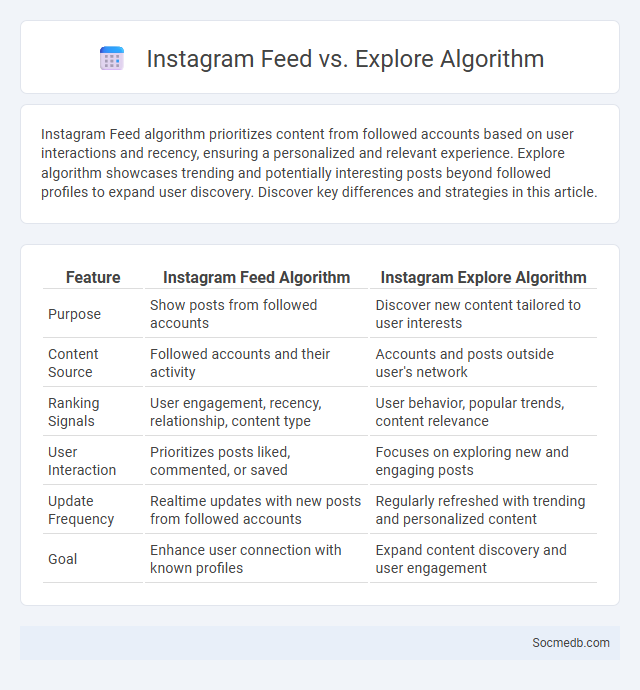
Photo illustration: Instagram Feed vs Explore algorithm
Instagram Feed algorithm prioritizes content from followed accounts based on user interactions and recency, ensuring a personalized and relevant experience. Explore algorithm showcases trending and potentially interesting posts beyond followed profiles to expand user discovery. Discover key differences and strategies in this article.
Table of Comparison
| Feature | Instagram Feed Algorithm | Instagram Explore Algorithm |
|---|---|---|
| Purpose | Show posts from followed accounts | Discover new content tailored to user interests |
| Content Source | Followed accounts and their activity | Accounts and posts outside user's network |
| Ranking Signals | User engagement, recency, relationship, content type | User behavior, popular trends, content relevance |
| User Interaction | Prioritizes posts liked, commented, or saved | Focuses on exploring new and engaging posts |
| Update Frequency | Realtime updates with new posts from followed accounts | Regularly refreshed with trending and personalized content |
| Goal | Enhance user connection with known profiles | Expand content discovery and user engagement |
Introduction to Instagram Algorithms
Instagram algorithms prioritize user engagement by analyzing interactions such as likes, comments, shares, and saves to tailor content feeds. These algorithms use machine learning to predict and display posts most relevant to individual users, enhancing user experience and retention. Understanding the key factors influencing Instagram's content ranking can significantly improve visibility and reach for creators and brands.
Understanding the Instagram Feed Algorithm
The Instagram feed algorithm prioritizes content based on user engagement, relevance, and timeliness to enhance personalized experiences. It analyzes factors such as user interactions, post frequency, and content type to rank posts in a user's feed. Understanding this algorithm enables creators to optimize content strategies, increase visibility, and foster meaningful audience connections on Instagram.
What Drives the Instagram Explore Algorithm
The Instagram Explore algorithm prioritizes content based on user interactions, such as likes, comments, shares, and saves, to personalize the feed and increase engagement. Machine learning analyzes behavior patterns, including the type of posts a user frequently views and engages with, to predict and surface relevant content. Factors like timeliness, content popularity, and user relationships also influence what appears on the Explore page, driving discovery and retention.
Key Differences Between Feed and Explore Algorithms
Feed algorithms prioritize content from users' direct connections, focusing on engagement signals like likes, comments, and shares to deliver personalized updates in chronological or relevance order. Explore algorithms leverage broader user behavior, interests, and trending topics to recommend content outside the user's network, aiming to discover new accounts and interests. This distinction drives feed content towards familiarity and engagement, while Explore pushes variety and content discovery for expanded user interaction.
How Algorithmic Ranking Impacts Content Visibility
Algorithmic ranking significantly influences content visibility by prioritizing posts based on factors such as user engagement, relevance, and timeliness. Platforms like Facebook, Instagram, and TikTok use complex algorithms to determine which content appears on your feed, often favoring content that aligns with your past interactions and preferences. Understanding these mechanisms helps you tailor your content strategy to maximize reach and engagement effectively.
User Behavior: Influence on Feed vs Explore
User behavior shapes content prioritization on social media platforms by influencing the algorithms that decide what appears in the Feed versus the Explore section. The Feed typically displays posts from followed accounts, emphasizing personal connections and engagement patterns, while the Explore page surfaces content based on broader interest signals such as trending topics and user interactions beyond the immediate network. Understanding the nuances of user interactions--likes, comments, shares, and time spent--enables platforms to optimize content delivery for enhanced personalization and discovery.
Content Strategies for Algorithmic Success
Consistently creating high-quality, relevant content tailored to your target audience significantly improves engagement rates, which positively influences social media algorithms. Utilizing a mix of formats such as videos, stories, and carousel posts increases visibility and interaction, driving algorithmic favor. Understanding platform-specific trends and scheduling posts during peak activity times further optimizes your content's reach and performance.
Updates and Changes in Instagram Ranking
Instagram ranking continuously evolves with updates prioritizing user engagement, relevance, and content quality to enhance your feed experience. New algorithms emphasize video content, especially Reels, boosting visibility for creators utilizing these formats. Regularly adapting to Instagram's ranking changes ensures your content maintains optimal reach and interaction.
Challenges Creators Face with Algorithms
Social media creators often struggle with ever-changing algorithms that impact content visibility and audience reach. These algorithms prioritize engagement metrics, making it difficult for creators to consistently gain exposure without adapting their strategies. Understanding how these algorithmic shifts affect Your content performance is crucial for maintaining growth and relevance online.
Future Trends in Instagram Algorithm Development
Instagram's algorithm is evolving to prioritize personalized content, leveraging advanced AI and machine learning to enhance user engagement by predicting preferences more accurately. Future trends indicate increased emphasis on video content, particularly Reels, and the integration of augmented reality features to create immersive user experiences. Enhanced data privacy measures and transparency in content ranking are also expected to shape the platform's algorithm development.
 socmedb.com
socmedb.com